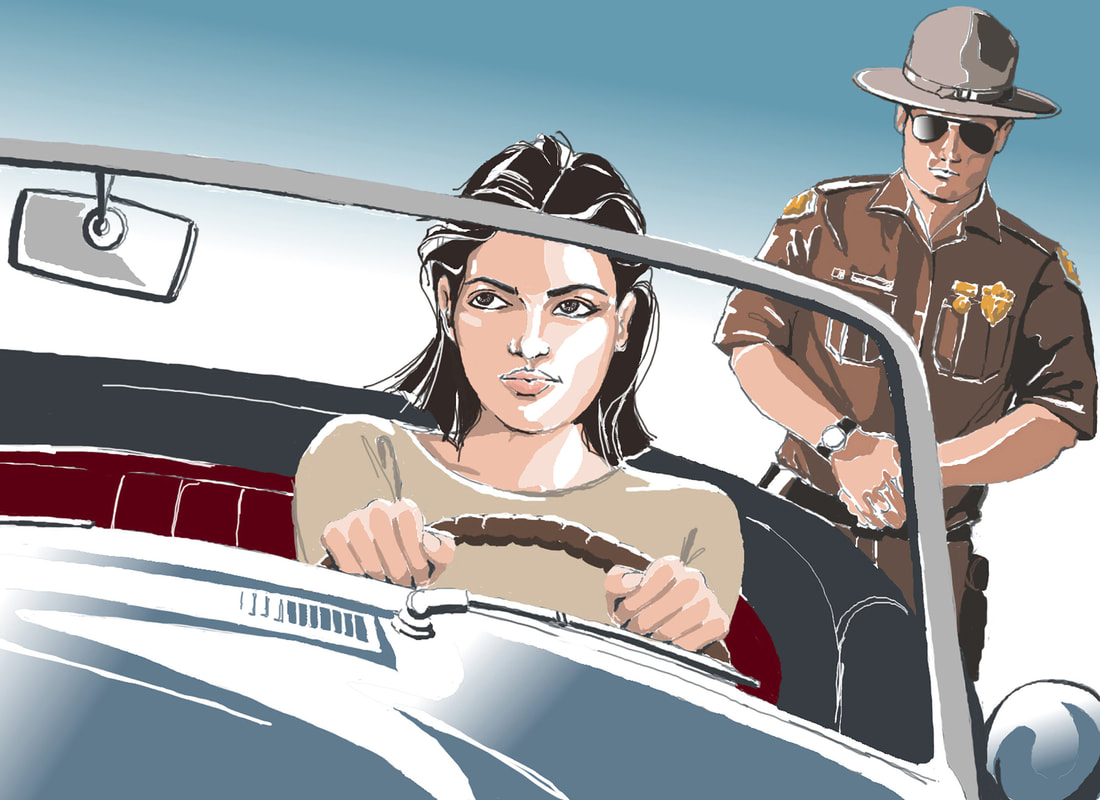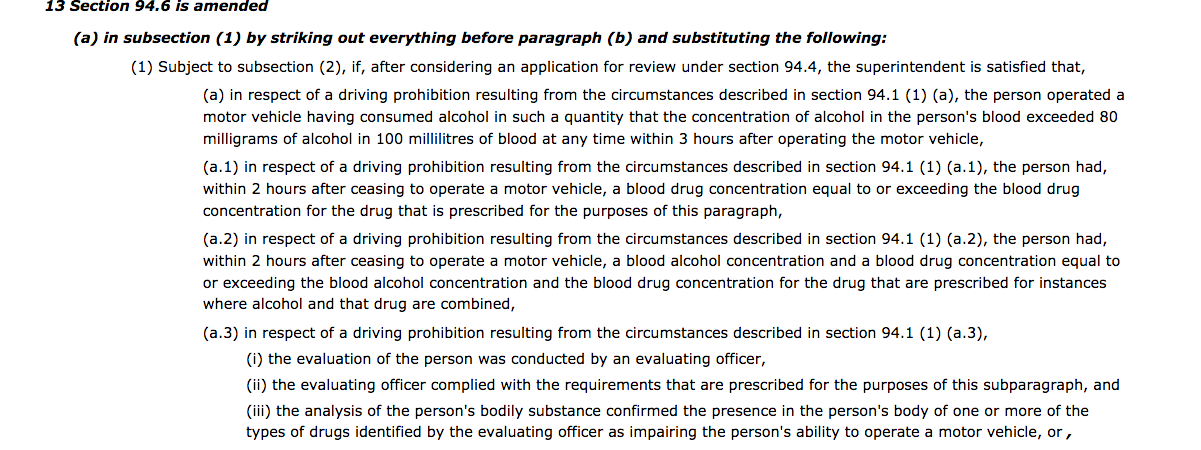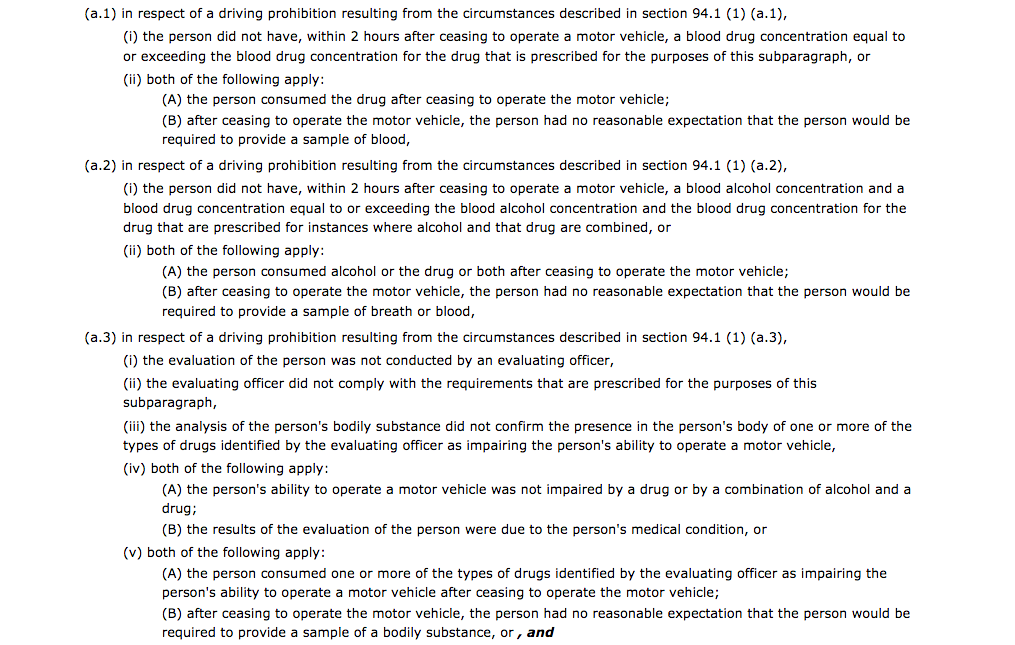12 Hour Prohibitions for Drugs
What the amendments do is create a 12-hour automatic suspension for any Class 7 N or Learner driver who has the presence of a drug or alcohol in their body. The person can then be issued a 12-hour prohibition on the basis of failing a test on a drug screening device. What is particularly interesting about this is that the drug screening device is not defined, and it is open to the Legislature to prescribe any type of drug screening device, at any time.
Here’s a look at the provision.
These laws are clearly flawed. Firstly, to regulate a zero-tolerance policy for the presence of drugs in the body will only lead to wrongful penalties for young drivers. It is possible to have measurable concentrations of THC, or other drugs, in the body with absolutely no impairing effects. Indeed, with respect to THC, it is possible to have THC in your body weeks after the effects of the drug have worn off. And so this will create a huge problem for people who have abstained for days, or weeks, and are then issued a prohibition.
Even people who have never used marijuana are at risk of being penalized under this law, given how second-hand cannabis smoke can be present in measurable levels in drug tests. Youth with parents or older siblings who use marijuana at home may therefore be negatively affected by the actions of others, and may face suspension.
But it gets worse. Because there is now a 12-hour prohibition for drugs and a 12-hour prohibition for alcohol, the provisions are likely to be reflected on the record as such. This means that a person who has received a 12-hour suspension could have a “drug-related” entry on their Motor Vehicle record. We have seen already cases where individuals are penalized at the border for having drug-related offences on their record. Canadians may be denied entry to the United States — even for life — because of a 12-hour prohibition.
And all that might be tolerable — it might be something we could stomach under the guise of road safety — if it were not the case that 12-hour suspensions currently lead to longer prohibitions under Section 93 of the Motor Vehicle Act and the so-called Driver Improvement Program. So not only could a person lose their license for twelve hours, but they will ultimately lose it for one to three months, based on their record after the 12 hours are up.
And even still, the unfairness and injustice of this is not done. Despite the fact that the prohibition triggers a longer suspension, and despite the fact that it can be detrimental to travel, and despite the fact that it is a permanent drug-related black mark on your driving record, there are no dispute provisions.
For a Government that was so critical of the previous Liberal Government for failing to create a fair method to dispute and challenge roadside suspensions, this Government has been an absolute failure at putting their words into action. It is injustice at its highest.
And while the Government has not, as of yet, revealed what it will be using for drug screening devices all accounts so far point to the fact that saliva testing equipment will most likely form the basis of the prohibitions. With the fatal flaws present in drug saliva testing being what they are, including temperature sensitivity issues and false positives, prohibiting a driver for twelve hours may make sense but prohibiting a driver for twelve hours with all the other collateral consequences is completely out of step.
Young people will be disproportionately negatively affected by this, and it is an unfair mechanism that will only destroy young lives well before they get a chance to begin.
90 Day Prohibitions for Drugs
The second category of prohibition proposed by the Government is a 90-day Prohibition for drugs. These are in and of themselves an unwieldy thing, but also have the potential to significantly affect drivers.
The provisions are somewhat confusing, but essentially a person can lose their license for 90 days for one of three separate reasons, all of which are related to drugs. These are set out in the following provisions:
- A blood test showing a level of drugs in the blood above a certain amount, taken within two hours of driving;
- A combination of a blood test showing a level of drugs in the blood above a certain amount and a blood alcohol concentration in excess of a certain amount, which appears to be lower for a combination of alcohol and drugs;
- A Drug Recognition Evaluation which shows the impairment by a particular type of drug, coupled with a blood or urine test showing the presence of that drug, and evidence of some unusual or poor driving.
It is refreshing, I must admit, to see at least one of these three provisions require evidence of poor driving. Since the issue is public safety, it would seem to me to make sense that poor driving be a criteria on which these provisions are based. Unfortunately, it does not appear necessary for there to be any bad driving with an unlawful blood drug concentration.
Breaking these down further becomes somewhat more complex. The Government has not introduced any provisions that relate to the concentrations of any drugs that are permissible, and so we do not know what the blood drug concentrations that will be relied on by the province will be. However, it is likely safe to assume that they will be close to or the same as the federal blood drug concentration rules.
Here’s where it gets interesting. The 90-day prohibition for drugs does not begin until seven days after the prohibition is served on the driver. There is also a seven-day limitation period to dispute the prohibition.
The review provisions are a beast unto themselves. Here are the grounds of review that must be proven by the officer in order to have the prohibition confirmed:
- The driver had a blood drug concentration, or a combined blood drug and alcohol concentration in excess of the legal limit;
- That the Drug Recognition Evaluation was done properly, by a qualified officer, and that the drugs from the analysis matched the opinion of the Drug Recognition Evaluator.
This is highly interesting, because currently the grounds of review for alcohol-related 90-day prohibitions are mirror images of one another: If X is proven, then confirm. If X is not proven, then revoke. However, the changes to the law actually eliminate that mirror-image provision. Instead of how it has typically been interpreted, with the onus on the officer to justify the prohibition on a balance of probabilities, the onus is now on the officer to make a prima facie case. Then the burden shifts to the driver to prove a number of things.
Here is what you have to prove, according to the legislation, to have your prohibition revoked:
It’s not well.
And here’s a breakdown of all of that very confusing language of what the driver needs to prove to have the 90-day prohibition for drugs revoked. Proving any one of these things on a balance of probabilities will require the Superintendent to revoke the prohibition.
- The blood drug concentration or combined blood alcohol and drug concentration did not exceed the blood drug limit;
- That the drugs or alcohol which showed up in the testing were taken after the driving finished, and in circumstances where it was not reasonable to assume a blood test would be taken;
- That the person who conducted the Drug Recognition Evaluation was not qualified to do it, or did not comply with the requirements, or that the subsequent test did not confirm the presence of the drug the DRE officer thought was there;
- That the driver was not impaired by a drug or a combination of alcohol and drugs but instead was impaired by a medical condition.
So if the prohibition was served on the basis of a Drug Recognition Evaluation, the driver would have to prove that they were not impaired by a drug but also that the impairment was caused by a medical condition. This means that if you were impaired by fatigue, for example, you have no defence.
Curiously, the “circumstances relating to the operation of the motor vehicle” is not a ground of review. So while it is a mandatory requirement to serve the prohibition, the absence of that requirement would not, following the Wilson decision from the Supreme Court of Canada, actually affect the validity of the prohibition on review.
Hollow words in a statute.
And while some of these provisions appear to mimic each other, the overall effect eliminates that mirroring of the burdens resulting in a prima facie case, onus shift situation, which is not something that we have had in the scheme thus far.
Also interesting is the infringement on the right to silence in the review hearing. It would be virtually impossible to prove any of the grounds of review without providing some evidence in the hearing. This means that drivers are going to be required to submit evidence in all cases, which increases the complexity of the reviews and will only lead to further judicial reviews on the basis of credibility disputes.
Equally problematic is that much of that evidence is not evidence an applicant can obtain. Because THC and other drugs do not eliminate from the body in a stable or consistent way, it is not possible to show that, for example, smoking one gram of marijuana would result in a blood drug concentration of XX, which would have eliminated to YY by the time the vehicle was being driven. The only practical defence would be if the testing showed a lower number after all.
You will note that the legislation does not contain provisions related to the reliability of the test results — a ground of review we saw added to the Immediate Roadside Prohibition legislation following the decision in Sivia which found the law unconstitutional for failing to have a fair and effective means to challenge the results of the test.
And yet, here we are. A complete failure to have a fair and effective means to challenge the results of the test. Did this Government learn nothing from their predecessors?
Ultimately, this legislation is inherently problematic, full of holes, and likely to be successfully challenged both on its constitutional validity and is practical ability to be administered. It creates impossible burdens, shifts the onus where it was not shifted before, and fails completely to address the problem of drug-impaired driving in any meaningful, efficient, and effective way.
I look forward to the first case I receive under this regime, as I will absolutely be challenging it in court.




